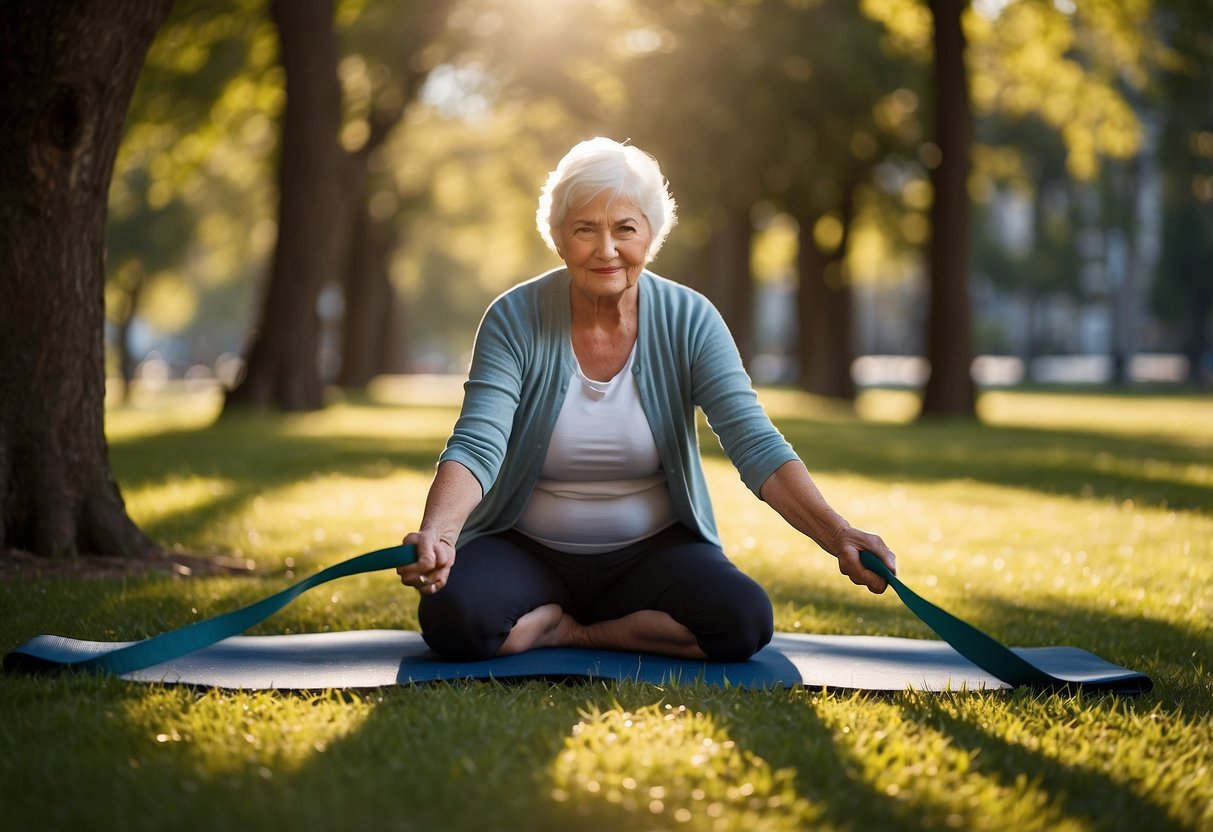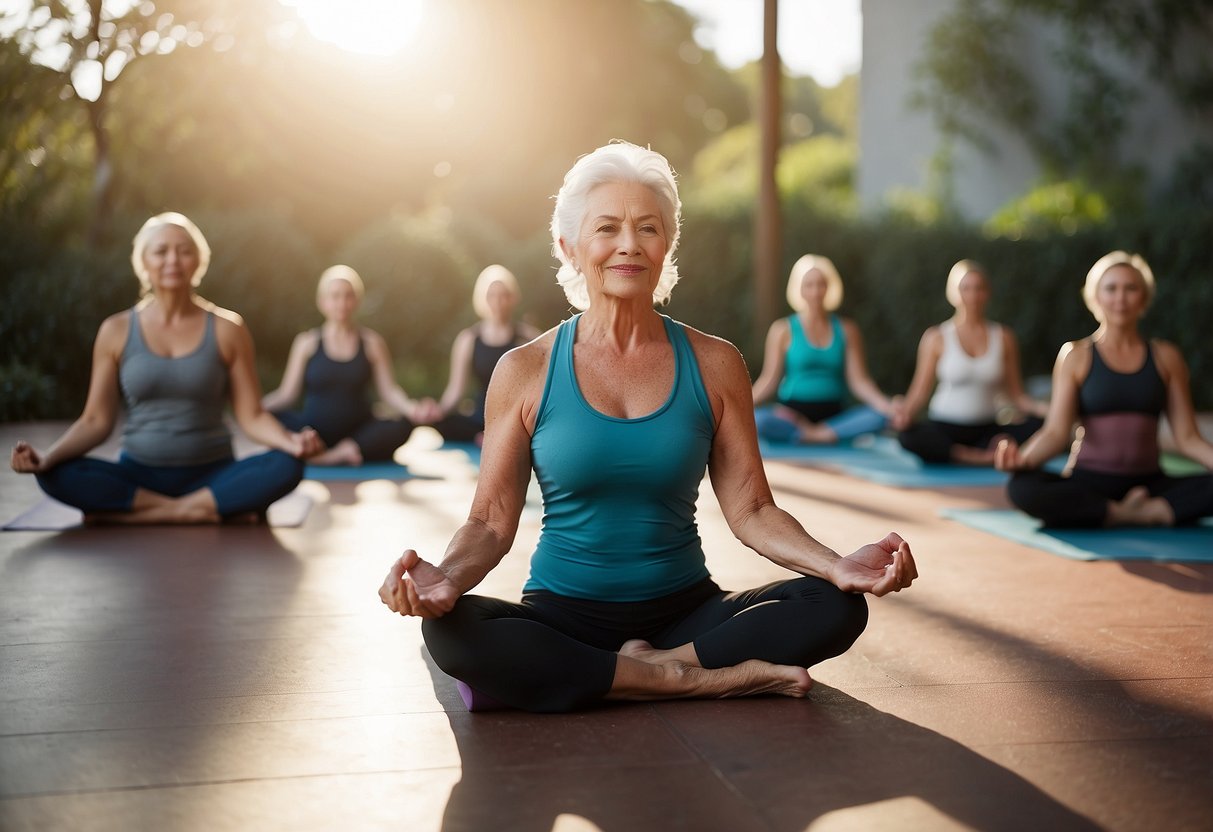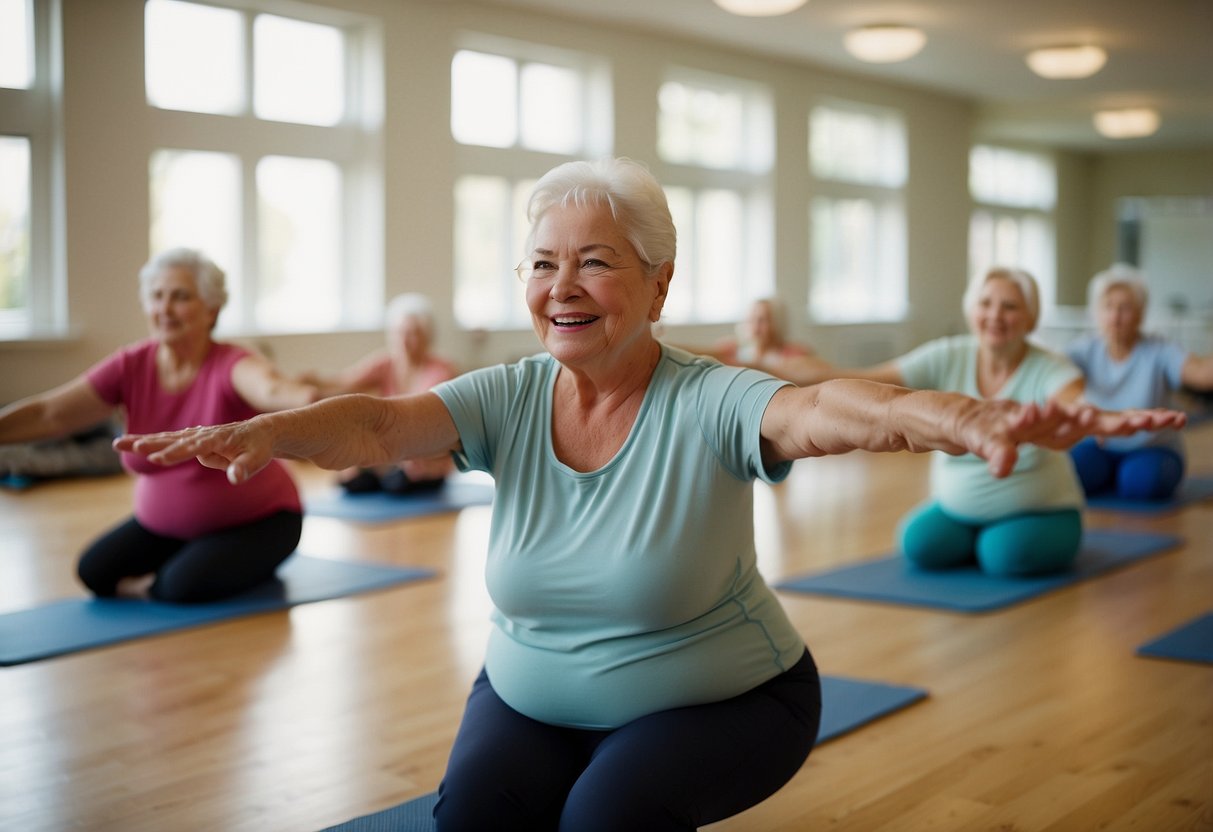Keeping your bones strong and healthy becomes even more important as we age, and the good news is, that exercise can make a big difference! From simple activities like walking and dancing to gentle strength training, moving your body helps build and maintain bone density, improves balance, and keeps you feeling fit and independent. It’s not just about staying active—it’s about giving your bones the love they need to keep you strong and steady. Let’s dive into how exercise can boost your bone health and keep you feeling your best at any age!
Exercise and Bone Health for Seniors: Simple Ways to Stay Strong
As we age, our bones can become weaker and more prone to fractures. But don’t worry – there’s good news! Regular exercise can help keep your bones strong and healthy, even in your golden years.

Exercise isn’t just about staying fit or losing weight. For seniors, it’s a powerful tool to maintain bone density and reduce the risk of falls. From walking to weightlifting, there are many ways to boost your bone health through physical activity.
Ready to get moving? Let’s explore how exercise can help you build stronger bones and enjoy a more active lifestyle. We’ll look at the best types of exercises for seniors and how to start safely.
Key Takeaways
- Regular exercise helps maintain bone strength and reduce fall risk in seniors
- A mix of weight-bearing and resistance exercises is best for bone health
- Consult your doctor before starting a new exercise program to ensure safety
Understanding Bone Health in Seniors
As you age, your bones change. Knowing what affects bone health and how exercise helps is key. Let’s look at how bones age, what puts them at risk, and why staying active matters.
The Aging Skeleton
Your bones don’t stay the same as you get older. After 30, you start to lose more bone than you make. This can lead to weaker bones over time. Women lose bone faster after menopause. This is due to less estrogen, which helps keep bones strong.
Your bones also get less dense and more brittle. This raises the chance of breaks, even from small falls. Height loss is common too. The cushions between spine bones shrink, making you shorter.
Risk Factors for Bone Loss
Some things make bone loss worse. These include:
- Not enough calcium or vitamin D
- Smoking
- Drinking too much alcohol
- Not being active enough
- Some medicines, like steroids
- Being very thin
Your genes play a role too. If your parents had weak bones, you might too. Some health issues can harm bones. These include thyroid problems and osteoporosis.
Benefits of Exercise for Bone Density
Exercise is great for your bones. It helps them stay strong and dense. Weight-bearing exercises are best. These include:
- Walking
- Dancing
- Climbing stairs
These activities make your bones work against gravity. This tells your body to build more bone. Strength training is good too. It can slow bone loss and build muscle to support your bones. Balance exercises help prevent falls. This lowers your risk of breaks. Regular exercise also boosts overall health. This helps your body build and maintain bone.

Types of Exercises Beneficial for Bone Strength
Regular exercise is key for keeping your bones strong as you age. Different types of physical activity work together to build and maintain bone density, improve balance, and reduce fracture risk.
Weight-Bearing Exercises
Weight-bearing exercises force your body to work against gravity, which helps strengthen bones. These activities include:
- Walking
- Jogging or running
- Dancing
- Hiking
- Climbing stairs
- Tennis
Try to do weight-bearing exercises for at least 30 minutes a day, 3-4 times a week. If you’re new to exercise, start with short walks and gradually increase your activity level. For lower-impact options, consider using an elliptical machine or doing low-impact aerobics. These can be gentler on your joints while still providing bone-strengthening benefits.

Strength Training Workouts
Strength training exercises use resistance to build muscle and bone strength. You can use:
- Free weights
- Resistance bands
- Weight machines
- Your own body weight
Aim to do strength training exercises 2-3 times a week, targeting all major muscle groups. Start with light weights and gradually increase as you get stronger. Some effective strength training exercises include:
- Squats
- Lunges
- Push-ups
- Bicep curls
- Shoulder presses
Remember to breathe normally and maintain good form to avoid injury. If you’re unsure about proper technique, consider working with a fitness trainer.

Balance and Flexibility Routines
Balance and flexibility exercises help prevent falls and improve overall mobility. These exercises include:
- Tai chi
- Yoga
- Pilates
- Simple balance exercises like standing on one foot
Try to incorporate balance and flexibility exercises into your routine 2-3 times a week. You can start with short 10-15 minute sessions and gradually increase the duration. Postural stretching and strengthening can also help improve your posture and reduce the risk of fractures. Focus on exercises that target your back muscles and core.
Always listen to your body and stop if you feel pain. It’s a good idea to talk to your doctor before starting a new exercise program, especially if you have osteoporosis or other health conditions.

Designing an Exercise Program for Seniors
A good exercise plan for seniors starts with knowing your fitness level and setting goals. It includes different types of activities to keep you healthy and strong.
Assessing Fitness Levels
Before you start exercising, it’s important to know where you stand. You can take simple tests to check your strength, balance, and flexibility. These tests help figure out what exercises are right for you.
Ask your doctor about fitness tests. They might check how far you can walk in 6 minutes or how many times you can stand up from a chair in 30 seconds. You can also try balance tests at home. Stand on one foot and see how long you can hold it. This gives you an idea of your balance skills.
Setting Realistic Goals
Now that you know your fitness level, it’s time to set goals. Think about what you want to achieve. Do you want to feel stronger? Improve your balance? Have more energy? Write down your goals. Make them specific and achievable.
For example, “I want to walk for 15 minutes without stopping” is a good goal. Start small and build up slowly. You might aim to exercise for 10 minutes a day at first. Then, add a few minutes each week. Creating goals helps you stay motivated and track your progress.

Creating a Balanced Routine
A good exercise plan includes different types of activities. This helps keep you healthy and prevents boredom. Try to include these four types of exercise:
- Strength training: Use weights or resistance bands 2-3 times a week.
- Aerobic exercise: Walk, swim, or dance for 30 minutes most days.
- Balance exercises: Practice standing on one foot or tai chi.
- Flexibility: Stretch or do yoga to stay limber.
Mix up your exercises to work different parts of your body. This helps prevent injury and keeps things interesting. Start with short sessions and slowly increase the time and intensity. Always listen to your body and stop if you feel pain.
Safety and Precautions During Exercise

Staying safe while exercising is key for seniors. You can avoid injuries, work within your limits, and adjust activities to fit your needs. These steps help you get the most out of exercise with less risk.
Avoiding Injury
Start slow and warm up before any workout. This gets your body ready and cuts down on strain. Wear comfy clothes and shoes that fit well. Good footwear helps prevent falls and foot pain.
Don’t push too hard. If you feel pain, stop right away. Sharp pain is a warning sign. Listen to your body and take breaks when you need them. Use the right form for each exercise. Bad form can hurt you. If you’re not sure, ask a trainer or doctor to show you. They can teach you safe ways to move.
Understanding Limitations
Know what you can do safely. Talk to your doctor about any health issues you have. They can tell you what exercises are best for you. Set realistic goals. Don’t try to do too much too fast. Slowly build up how long and hard you work out. This helps your body get stronger over time.
Be aware of how medicines affect you. Some may make you dizzy or tired. This can raise your risk of falling during exercise. Ask your doctor if you should change when you take your meds.
Adapting Exercises for Individual Needs
There’s no one-size-fits-all plan for seniors. Find activities you enjoy and that work for your body. If you can’t do one exercise, try another that works the same muscles. Use props to make moves easier or harder. A chair can help with balance. Resistance bands are great for strength training. They’re easy to adjust as you get stronger.
Try water exercises if you have joint pain. The water supports your body and makes moving easier. Swimming and water aerobics are good choices.
Nutrition and Bone Health

Good nutrition is key for keeping your bones strong as you age. What you eat plays a big role in bone health. Let’s look at some important nutrients and diet tips to help your bones stay healthy.
Essential Nutrients for Strong Bones
Calcium is vital for bone strength. You can get it from dairy products, leafy greens, and fortified foods. Aim for 1,000-1,200 mg daily. Vitamin D helps your body absorb calcium. Sunlight, fatty fish, and fortified foods are good sources. Try to get 600-800 IU per day.
Protein is crucial for bone health too. Eat lean meats, fish, eggs, and beans. About 1 gram per kilogram of body weight daily is ideal. Other key nutrients include:
- Magnesium: Found in nuts, seeds, and whole grains
- Vitamin K: In leafy greens and vegetable oils
- Potassium: Abundant in fruits and veggies
Dietary Considerations and Supplements
A balanced diet is best for bone health. Eat lots of fruits and veggies. They’re packed with nutrients your bones need. Limit salt, caffeine, and alcohol. These can make your body lose calcium.
If you can’t get enough nutrients from food, talk to your doctor about supplements. They might suggest calcium and vitamin D pills. Drink water instead of sugary drinks. It helps your body absorb nutrients better. Remember, your bones need good food just like the rest of your body. Eating right can help keep them strong for years to come.

Monitoring Progress and Health
Keeping track of your bone health is key as you age. Regular check-ups and exercise tracking help you stay on top of your progress and catch any issues early.
Regular Check-Ups with Healthcare Providers
Make sure to see your doctor at least once a year for a bone health check-up. They may suggest bone density scans to track changes over time. These tests are painless and quick.
Your doctor can also check your vitamin D levels. This vitamin is crucial for strong bones. If your levels are low, they might suggest supplements. Blood tests can reveal other factors affecting bone health. These include hormone levels and markers of bone turnover. Your doctor will explain what these mean for you.
Don’t skip these visits. They’re your best tool for spotting problems before they get serious.
Tracking Exercise and Its Effects
Keep a log of your bone-strengthening exercises. Note what you do and how often. This helps you see your progress over time. Use a simple chart or notebook. Write down:
- Type of exercise
- Duration
- How you felt during and after
Pay attention to changes in your strength and balance. Can you lift more weight? Stand on one foot longer? These are good signs. Take note of any pain or discomfort. If something hurts, tell your doctor. They can help adjust your routine. Consider using a fitness tracker. It can count steps and monitor your activity levels. Some even track sleep, which is important for bone health too.
Community and Support

Staying active and maintaining bone health is easier with help from others. Groups and loved ones can provide motivation, accountability, and assistance with exercises.
Exercise Groups and Classes
Joining exercise groups for seniors can make working out fun and social. Look for classes at your local community center, YMCA, or senior center. Many offer low-impact options like water aerobics, tai chi, or chair yoga.
These group activities help you stay motivated and make new friends. You’ll learn proper form from trained instructors to avoid injury. Some classes focus on bone-strengthening exercises using light weights or resistance bands.
Try different classes to find what you enjoy most. Bring a friend or neighbor along for extra support and companionship.
Family and Caregiver Support
Your family and caregivers play a key role in your bone health journey. Ask them to join you for walks or gentle exercises at home. Their encouragement can keep you going on tough days.
Caregivers can help set up a safe exercise space and remind you of appointments. They may assist with transportation to classes or doctor visits. Share your bone health goals with them so they understand their importance.
Family members can learn exercises to do together during visits. This creates quality time while supporting your health. Ask them to check in regularly about your progress and celebrate small wins with you.

Advancements in Senior Fitness and Bone Health Research
Recent studies have shed new light on how you can keep your bones strong as you age. Exercise plays a crucial role in maintaining bone health. Adding some impact to your workout routine can make a big difference.
Scientists have found that putting gentle pressure on your bones during exercise helps them stay strong. This doesn’t mean you need to start jumping or running if that’s too much for you. Even brisk walking can provide enough impact to benefit your bones.
Balance training is another important focus. It helps prevent falls, which is crucial for protecting your bones. Activities like Tai Chi and yoga can improve your balance and coordination. Research also shows that calcium intake remains vital for seniors. Aim for 1,200 milligrams daily. You can get this from dairy products, fortified juices, and leafy greens like kale.
A recent analysis of exercise studies found that various types of physical activity can improve your overall function. This includes strength training, aerobic exercise, and flexibility work. Remember, it’s never too late to start caring for your bones. Regular check-ups and a mix of different exercises can help you maintain strong bones and stay active as you age.
Fun Facts
Did you know that weight-bearing exercises like walking, dancing, and even gardening are fantastic bone density boosters? These activities put just the right amount of stress on your bones, stimulating new bone growth and slowing down natural bone density loss. It’s a fun and effective way to keep your skeleton strong and resilient as you age!
Exercise And Bone Health In Seniors: Your Body, Your Power
Exercise is one of the best ways to keep your bones strong and healthy as you age. Whether it’s a daily walk, a fun dance class, or some light strength training, staying active helps protect your bones, improve your balance, and keep you feeling vibrant and independent. So why not make movement a part of your routine? Grab a friend, head outside, or try a new class—your bones will thank you! Start small, keep it fun, and let’s move toward better bone health together!
Ready to get moving? Share your favorite bone-strengthening exercises and tips with our community. Let’s inspire each other to stay active and healthy.
Frequently Asked Questions

Seniors can improve bone health through safe exercises and activities. These questions cover key aspects of bone-strengthening workouts for older adults.
How can seniors safely improve bone density in the spine through exercise?
You can boost spine bone density with gentle exercises. Try standing backbends or wall slides. These moves put light pressure on your spine. Always start slow and listen to your body. If you feel pain, stop and talk to your doctor.
What are some bone-strengthening exercises seniors can do at home?
You can do many bone-boosting exercises at home. Try walking in place or marching. Bodyweight squats and wall pushups are great too. Use soup cans or light weights for arm curls. Always focus on good form to avoid injury.
Are there specific exercises to avoid for those with osteoporosis?
If you have osteoporosis, skip high-impact activities. Avoid jumping, running, or sudden twisting motions. Don’t do exercises that bend your spine forward, like toe touches. These can raise your risk of fractures.
Can seniors enhance bone density after age 60, and how?
Yes, you can improve bone density after 60. Regular exercise helps build and maintain strong bones. Focus on weight-bearing exercises like walking or dancing. Strength training with light weights or resistance bands also helps.
What are effective weight-bearing exercises for seniors with osteoporosis?
Safe weight-bearing exercises include low-impact activities. Try brisk walking, using an elliptical machine, or low-impact aerobics. Tai chi and gentle yoga can improve balance and strength. Always get your doctor’s okay before starting new exercises.
What activities are recommended for older adults to prevent osteoporosis?
To prevent osteoporosis, do a mix of exercises. Walking, climbing stairs, and dancing are great options. Add strength training twice a week. This can include lifting weights or using resistance bands. Balance exercises like standing on one foot also help prevent falls.
Stay Fit, Feel Good!
Looking for fitness inspiration? Visit our Facebook page for tips, tricks, and workout routines tailored for people aged 55 and above. Join our active community and discover ways to stay healthy, active, and happy. Let’s prioritize fitness together!

